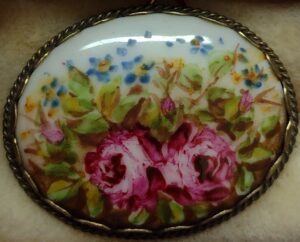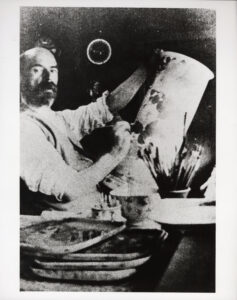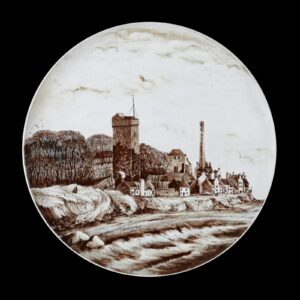A ceramic brooch made by the Bohemian craftsman who created an iconic Scottish pottery brand is being exhibited near where he worked.
The floral-patterned keepsake, which Wemyss Ware designer Karel Nekola gifted to his wife more than 100 years ago, is being loaned to Kirkcaldy Galleries by his granddaughter.
The brooch’s vibrant cabbage rose motif is typical of Nekola’s free-flowing style, which helped Fife Pottery capture a global market that included Britain’s royal household.
Nekola’s output included a ceramic goblet made for Queen Victoria’s Diamond Jubilee that featured in a BBC One Repair Shop special with the former Prince of Wales.

Karel Nekola brooch.
The artist’s vivid pink roses appear on more than one third of Wemyss Ware produced at Fife Pottery’s factory in Gallatown, Kirkcaldy.
Their naturalistic style had instant appeal. The artist’s daughter, Mariebelle, once recalled that when her father painted roses, “you really wanted to smell them.”
Nekola’s hand-painted designs of flowers, fruit and animals became hugely popular at home and abroad. Ornaments shaped as pigs and cats were also big sellers.
The brooch, which is on display until May, is one of four that Nekola designed for his wife and three daughters between 1910 and 1915.
‘We are delighted to make such a charming, personal item accessible to our visitors over the coming year,’ said OnFife Collections Curator Jane Freel.
‘The brooch sits very well with other pieces in our collection that were decorated by this significant artist.’
Also on show is a plate – signed by Nekola – depicting Dysart harbour, as well as paints and a brush thought to have belonged to the artist.
Fife Pottery owner Robert Heron was a great admirer of hand-decorated ceramics and he embarked on a Grand Tour of Europe to recruit highly trained painters for his business.
Nekola was headhunted in present-day Czech Republic in 1883 and quickly made his mark in Kirkcaldy, just as Fife Pottery secured a major backer.
Heron gained hugely influential patronage from Miss Dora Erskine Wemyss, of nearby Wemyss Castle, and named his new pottery range after her family.

Karel Nekola
When upmarket tableware retailer Thomas Goode of London gained the exclusive right to sell Wemyss Ware in the south of England, sales flourished.
Nekola settled in Kirkcaldy and became Fife Pottery’s chief designer. He married the Heron family’s cook, Isabella Thomson, in 1884 and the couple had six children.
When the artist’s health began to deteriorate in 1910, a pottery was built at his home so he could continue working. Nekola died in 1915.
Fife Pottery was the largest of four ceramic factories in Kirkcaldy at the time – alongside Links, Sinclairtown and Rosslyn Potteries.
They exported goods worldwide but, by the 1930s, all four had closed in the face of cheaper alternatives, foreign competition and economic depression.
Production rights for Wemyss Ware were bought by a ceramics company in Devon and later moved to Royal Doulton. They returned to Fife in 1995 when they transferred to Griselda Hill Pottery in Ceres, where the brand is still produced.

Wemyss Ware Dysart plaque – painted by Nekola.
A large plate made by Griselda Hill, which depicts Karel Nekola painting a large vase, is included in the display. The image is based on an archive photograph.
The display is part of a wider initiative that is seeking to raise awareness of Fife’s distinguished pottery making past, which is often eclipsed by linoleum manufacture.
Read more on Scottish Field’s News pages.
Plus, don’t miss the October issue of Scottish Field magazine.
TAGS

